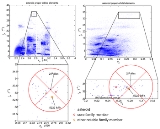
Pallas family
Overview
Asteroid family
An asteroid family is a population of asteroids that share similar proper orbital elements, such as semimajor axis, eccentricity, and orbital inclination. The members of the families are thought to be fragments of past asteroid collisions...
is a grouping of B-type
B-type asteroid
B-type asteroids are a relatively uncommon type of carbonaceous asteroid, falling into the wider C-group. In the asteroid population, B-class objects are abundant in the outer asteroid belt, and also dominate the high-inclination Pallas family which includes the second-largest asteroid 2 Pallas...
asteroid
Asteroid
Asteroids are a class of small Solar System bodies in orbit around the Sun. They have also been called planetoids, especially the larger ones...
s at very high inclination
Inclination
Inclination in general is the angle between a reference plane and another plane or axis of direction.-Orbits:The inclination is one of the six orbital parameters describing the shape and orientation of a celestial orbit...
s in the intermediate asteroid belt
Asteroid belt
The asteroid belt is the region of the Solar System located roughly between the orbits of the planets Mars and Jupiter. It is occupied by numerous irregularly shaped bodies called asteroids or minor planets...
(Cellino et al. (2002)). It was first noted by Kiyotsugu Hirayama
Kiyotsugu Hirayama
was a Japanese astronomer, best known for his discovery that many asteroid orbits were more similar to one another than chance would allow, leading to the concept of asteroid families, now called "Hirayama families" in his honour....
in 1928.
The namesake of the family is 2 Pallas
2 Pallas
Pallas, formally designated 2 Pallas, is the second asteroid to have been discovered , and one of the largest. It is estimated to constitute 7% of the mass of the asteroid belt, and its diameter of 530–565 km is comparable to, or slightly larger than, that of 4 Vesta. It is however 20%...
, an extremely large asteroid with a mean diameter of about 550 km. The remaining bodies are far smaller; the largest is 5222 Ioffe
5222 Ioffe
5222 Ioffe is a main-belt asteroid discovered on October 11, 1980 by Chernykh, N. S. at Nauchnyj. It is the largest of the Palladian asteroids apart from Pallas itself.- External links :*...
with an estimated diameter of 22 km. This, along with the preponderance of the otherwise rare B spectral type among its members, indicates that this is likely a cratering family composed of ejecta from impacts on Pallas.

